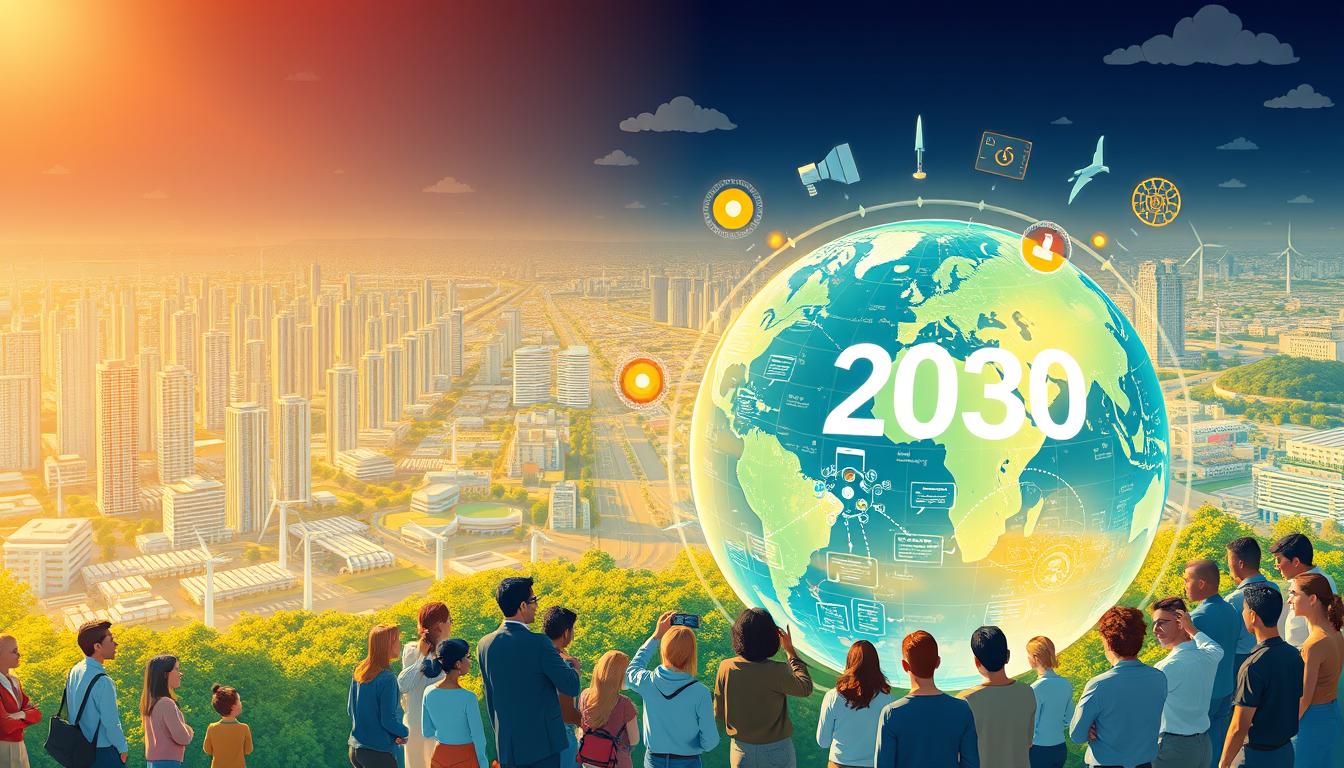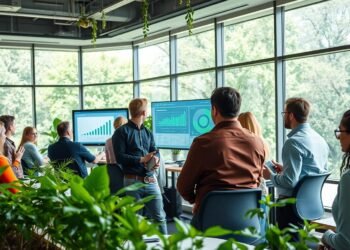Can a single global plan change how we protect the planet and improve lives in U.S. towns at the same time?
This guide frames the 2030 Agenda from the United Nations as the organizing blueprint for the 17 goals. It explains why a joined approach matters across climate, economy, and society.

Readers will find clear guidance on where to get official information and publications, how progress is tracked, and which reports shape policy. We highlight the Division for Sustainable Development Goals (DSDG) and UNDESA’s role in technical support and partnerships.
This is an evidence-based, practical roadmap for U.S. audiences. Expect explanations of the goals, links between emissions and health, and actionable steps for local planning and investment that boost resilience and impact into the future.
Key Takeaways
- The United Nations 2030 Agenda organizes 17 global goals that link people and planet.
- Official publications and indicators track progress and inform policy and practice.
- UN DESA’s DSDG provides guidance, data, and partnerships for implementation.
- Climate, emissions, and environment actions relate directly to health and lives.
- This guide connects global goals to local planning and measurable impact in the U.S.
What Is Sustainable Development? Core Principles, People and Planet
At its core, the idea asks how growth can include people while protecting nature. Sustainable development means meeting present needs without blocking future generations from meeting theirs. It balances economic growth, social inclusion, and environmental protection.
Balancing economic growth, social equity, and environmental protection
Policies that boost health and education also strengthen local economies and guard natural systems. This people planet link creates co-benefits: cleaner air raises productivity and lowers climate risks.
From concept to action: why sustainable development matters now
Goals set direction, while concrete solutions and investments turn aims into results. Governments, businesses, and communities translate targets into budgets, roadmaps, and accountability systems.
Across the United States, this approach guides infrastructure upgrades, workforce training, and resilience planning. Education and lifelong learning build the skills to innovate and adapt.
Public policy, transparent governance, and community participation ensure fair access to services that improve health. Individual choices and organizational strategies together drive measurable change.
From Rio to the 2030 Agenda: A Brief History and Policy Milestones
The global policy journey from Rio to 2015 set the stage for the 2030 agenda. Early milestones created the shared language and institutions that guide countries and stakeholders today.
Agenda 21, MDGs, and the path to the UN’s 17 goals
In 1992, more than 178 countries endorsed Agenda 21 at the Earth Summit in Rio. That text guided national action and multilateral cooperation for years.
In 2000, member states adopted the Millennium Declaration and eight Millennium Development Goals. Lessons from the MDGs widened the scope of later development goals to include social, economic, and environmental aims.
High-level Political Forum and UNDESA’s DSDG: coordination and guidance
Rio+20 in 2012 produced “The Future We Want” and launched the SDG process. An Open Working Group drafted targets, and in 2015 the united nations adopted the 17 goals.
The UNDESA Division for Sustainable Development Goals now provides guidance, technical support, and systemwide evaluation. Regular events, official publications, and periodic report cycles keep governments accountable while helping align national implementation on health, climate, and emissions.
Result: This multi-decade work mobilizes financing, builds capacity, and connects civil society, business, and governments to turn policy into action.
The 17 Sustainable Development Goals at a Glance
A concise view of the 17 goals helps readers see how health, education, energy, and cities link into one agenda. Below are one-line descriptions to scan priorities and spot where local actions can make a difference.
Ending poverty and hunger; promoting healthy lives and quality education
1–4: End poverty everywhere; end hunger and improve nutrition; ensure healthy lives for all ages; provide inclusive, quality education and lifelong learning.
Gender equality, water and sanitation, affordable and clean energy
5–7: Achieve gender equality and empower women; ensure water and sanitation for everyone; expand access to affordable, modern energy that lowers emissions.
Decent work, industry and innovation, and reduced inequalities
8–10: Promote decent work and inclusive growth; build resilient infrastructure and foster innovation; reduce inequality within and among countries.
Sustainable cities, responsible consumption, and climate action
11–13: Make cities inclusive and resilient; shift to responsible production and consumption patterns; take urgent action on climate and its impacts.
Life below water, life on land, peace and justice, and partnerships
14–17: Conserve oceans and marine life; protect terrestrial ecosystems and biodiversity; promote peaceful, accountable institutions; and strengthen global partnerships via UN publications and shared targets.
Implementation of the 2030 Agenda: Mechanisms, Stakeholders, and Policy Levers
Turning global aims into on-the-ground action requires rules, money, and clear leadership at every level. National plans convert the Agenda’s goal language into budgets, laws, and coordinated ministry work that reach cities and counties.

National strategies, member states’ commitments, and governance
Member states align ministries and local governments to embed targets into national development plans. This makes delivery practical and helps countries prioritize interventions with the biggest expected impact.
Financing, partnerships, and SDG Acceleration Actions
Public budgets, private finance, and technology together fund solutions. Voluntary SDG Acceleration Actions act as catalysts, linking investments and partnerships to faster execution.
Coordination, policy levers, and tracking progress
Regulation, incentives, procurement, and public‑private partnerships shift markets and unlock innovation. Inclusive processes engage stakeholders in design and delivery.
Transparent publications and UN guidance standardize methods and help governments track progress, assess impact, and adjust actions through iterative review.
Tracking Progress: Reports, Indicators, and Data for Decision-Making
Clear measurement turns global goals into usable priorities. Reports and open platforms give leaders the evidence they need to focus resources where they improve lives fastest.
Annual SDG Progress Reports and the Global Sustainable Development Report
The UN Secretary‑General’s annual SDG Progress Reports synthesize national inputs and regional aggregates to show where progress is steady and where gaps persist. They offer a yearly snapshot that informs budgets and program choices.
The Global Sustainable Development Report appears every four years from an Independent Group of Scientists. It brings systems thinking and scientific guidance to the quadrennial UN review and helps shape implementation 2030 agenda decisions.
Global indicator framework, data access, and using evidence for action
The global indicator framework and metadata are available at the UN Stats portal for consistent measurement across member states. Officials, analysts, and civil society use these official indicators to build national dashboards and local baselines.
Decision-makers combine reports, publications, and open data to target energy access, social services, and other priorities that support healthy lives. Events like the HLPF provide formal review moments that improve accountability and spark new actions.
Quality assurance, clear documentation, and stronger statistical capacity at local and national levels make indicators comparable and useful. Transparent tracking supports adaptive management and speeds learning across contexts.
Climate Change and Emissions: Integrating Mitigation, Adaptation, and Resilience
Rising temperatures and more extreme weather force practical choices for health, jobs, and nature. Goal 13 calls for urgent action on climate change and links to energy, oceans, transport, and cities through DSDG guidance.
Three pillars and health co-benefits
Mitigation cuts emissions with clean technology and efficiency. This lowers air pollution and improves public health.
Adaptation reduces risks—like heat waves and flooding—by protecting communities and hospitals.
Resilience helps people and infrastructure bounce back after shocks and reduces long-term impact.
Integrated solutions and equitable outcomes
Nature-based solutions and smart land use protect biodiversity while creating growth and jobs. Integrated planning across energy, transport, and land use maximizes mitigation and adaptation synergies.
Transparent emissions inventories, scenario planning, and risk metrics guide investments and track avoided losses. Inclusive policies must prioritize vulnerable groups to protect health and share benefits.
Collaboration and measurable action
Multi-stakeholder partnerships scale practical solutions with measurable outcomes. Clear targets aligned with national sustainable development strategies reinforce cross-goal alignment and long-term planning.
Energy, Cities, and Infrastructure: Systems Change for a Low-Carbon Future
Cities and power systems must be rethought together to cut emissions and widen access. This systems view links grid upgrades, urban planning, and transport to concrete gains in health, jobs, and resilience.
Affordable, reliable energy and grid transformation
Grid modernization, clean generation, storage, and demand flexibility expand energy access while lowering emissions. Smart meters and distributed storage help utilities balance peaks and keep costs down.
Key benefits: improved reliability, broader access, and lower greenhouse intensity for long-lived assets.
Resilient, inclusive cities and sustainable transport
Urban plans that mix housing, transit, and nature-based design deliver social and environmental benefits. Public transit, active mobility, and vehicle electrification cut congestion and pollution while improving opportunity.
Financing tools that de-risk private capital speed infrastructure build-out. Workforce training and local supply chains ensure equitable participation. City-scale pilots that align with federal incentives ladder up to national sustainable development goals and show measurable progress.
Protecting Oceans and Biodiversity: From Policy to On-the-Ground Impact
biodiversity underpins food security, livelihoods, and public health. Strong policy must translate into habitat protection, restoration, and local job programs that keep ecosystems productive.

Priority ocean actions include sustainable fisheries, pollution prevention, coastal resilience, and marine protected area networks. These steps restore stocks and protect coastal communities from storms.
On land, focused stewardship—forest management, targeted restoration, and invasive species control—reverses degradation and safeguards water and soil for farms and towns.
Use of natural resources can deliver economic benefits when managed to avoid depletion. Linking conservation to local markets helps communities earn while conserving natural capital.
Measurable actions need clear monitoring and enforcement. Remote sensing, vessel tracking, and community reporting produce data that show real impact on the environment.
Cross‑border coordination protects migratory species and shared waters. Nature‑based solutions also support climate adaptation and mitigation, multiplying benefits for people and places.
Education, Health, and Equity: People-Centered Development Goals
Investing in education and health creates the foundation for stronger communities across the United States. This section shows how learning, care, and fair opportunity work together to improve lives and spur inclusive growth.
Lifelong learning and workforce readiness
Early childhood programs, K–12 schools, and adult training build the skills base that supports innovation and local growth. Strong apprenticeship and community college pathways connect learners to good jobs and nearby employers.
What strong health systems deliver
Primary care, prevention, a trained workforce, and equitable access form the backbone of systems that deliver healthy lives. Community clinics, telehealth, and prevention programs reduce avoidable hospitalizations.
Targeted policies to reduce inequalities
Policies that expand opportunities for underserved groups — including women and girls — remove barriers to education, work, and care. Cash transfers, paid family leave, and targeted scholarships raise participation and outcomes.
Local solutions and digital inclusion
Community-based programs tailor services to cultural and geographic needs. Digital access and affordable broadband shape educational attainment and access to health information across towns and rural counties.
Integrated investments in housing, nutrition, and transport complement social services and boost overall well‑being. Continuous evaluation helps refine programs so resources reach the people who benefit most.
Sustainable development in the United States: Policies, Opportunities, and Actions
Local leaders in the United States are tapping global guidance to shape climate, housing, and transport priorities that deliver measurable results.
Federal, state, and city initiatives align through national plans, state programs, and city pilots that map to international principles. Agencies coordinate across housing, health, and energy to reduce overlap and speed funding to projects.
Stakeholders and practical solutions
Community groups, utilities, universities, and businesses collaborate on pilot projects and shared data platforms. These partners design solutions that match local needs and scale promising models.
Events, publications, and local stories
Engage with events and publications that share lessons from the HLPF and DSDG. Highlighted stories—from neighborhood resilience upgrades to statewide clean energy transitions—help spread effective actions and attract funding.
Use clear data to target programs, report progress, and communicate news. Governments and stakeholders who sustain this work through partnerships can scale successful approaches across regions while benchmarking against united nations frameworks.
Now and Next: Current Developments, Plastics Treaty Talks, and the Road to 2030
Diplomats and experts gather in Geneva from August 5–14 for INC‑5.2 to finalize the first international plastics treaty. This high‑profile meeting is news that matters to the 2030 agenda and the sustainable development goals.
A strong plastics agreement aims to cut environmental leakage and improve waste systems. That will deliver direct impact on marine ecosystems, coastal communities, and local jobs.
Plastic rules also touch climate and emissions by reducing lifecycle pollution from production through disposal. Clear reporting, transparency, and implementation mechanisms are likely to shape how countries track progress and verify actions.
U.S. stakeholders should prepare for new standards, certifications, and shifts in product design and supply chains. Early movers can win new markets as compliance needs create demand for circular solutions.
Follow official publications and UN events to track outcomes and translate them into practice. Look for case stories of circular economy pilots that can scale under a treaty and join public consultations to turn international commitments into local action.
Conclusion
Concrete progress follows when leaders use evidence to set priorities, track results, and adjust fast.
The guide shows how sustainable development turns economic, social, and environmental aims into practical pathways that deliver measurable impact.
Use the Annual SDG Progress Reports and the Global Sustainable Development Report as tools to assess progress and target action. The 2030 agenda remains the north star and the sustainable development goals anchor sector plans.
There is urgency to cut emissions while improving prosperity. Support implementation 2030 through partnerships, capacity investments, and transparent accountability.
Align local plans with the 2030 agenda, invest in data and people, and stay engaged. With steady measurement, adaptive management, and broad collaboration, the future can show faster, fairer progress.
FAQ
What does “Sustainable Development” mean and why does it matter?
It refers to meeting present needs without compromising the ability of future generations to meet theirs, by balancing economic growth, social equity, and environmental protection. This approach guides policy, finance, and community action to protect health, biodiversity, and livelihoods while enabling economic opportunity and resilient infrastructure.
How do the 2030 Agenda and the UN’s 17 goals guide national policy?
The 2030 Agenda sets time-bound targets that countries translate into national strategies and budgets. Member states use the goals to shape governance, create monitoring frameworks, and mobilize finance and partnerships with governments, cities, businesses, and civil society to accelerate progress.
What major milestones led from Rio to the current global goals?
Key steps include Agenda 21 from the 1992 Rio Earth Summit, the Millennium Development Goals (MDGs), and the 2015 adoption of the 17 UN goals. These milestones built coordination through forums such as the High-level Political Forum and guidance from UNDESA for implementation and reporting.
How is progress tracked on the goals and where can I find reliable data?
Progress is tracked through the global indicator framework, national reporting, annual SDG Progress Reports, and the Global Sustainable Development Report. Open data portals and UN databases provide access to indicators, emissions data, and evidence for policy decisions.
What role does climate action play within the goals?
Climate action links mitigation, adaptation, and resilience to protect lives, public health, and ecosystems. Integrating emissions reduction with nature-based solutions supports biodiversity, energy transition, and disaster risk management while creating green jobs and growth.
How can cities and infrastructure support a low-carbon future?
Cities can adopt resilient planning, sustainable transport, and green building standards. Transforming energy systems toward affordable, reliable, clean power and modernized grids enables decarbonization, improves air quality, and boosts sustainable economic development.
What financing and partnership mechanisms help implement the agenda?
Financing includes public budgets, climate finance, multilateral development banks, and private investment. Partnerships between governments, non-governmental organizations, the private sector, and academia accelerate innovation, scale pilot projects, and deliver social services and infrastructure.
How are health and education prioritized within the goals?
Targets emphasize healthy lives, universal health coverage, and lifelong learning to reduce inequalities. Investments in primary care, nutrition, and quality education enhance human capital, increase productivity, and build resilient communities.
What actions protect oceans and terrestrial biodiversity?
Actions include establishing marine protected areas, sustainable fisheries management, combating pollution such as plastic waste, restoring habitats, and enforcing conservation policies that balance livelihoods and ecosystem health.
How do gender equality and social inclusion fit into implementation?
Gender equality is central: empowering women and girls, ensuring equal access to education, finance, and leadership, and addressing structural barriers improves outcomes across health, employment, and governance.
Where can local stakeholders find tools and guidance for action?
Governments and cities can use UN guidance, national SDG strategies, sectoral reports, and toolkits from agencies like the World Bank or WHO. Events, publications, and technical assistance programs connect stakeholders to best practices and funding opportunities.
What is the connection between plastics treaty talks and the 2030 Agenda?
International negotiations on a plastics treaty aim to reduce pollution across land and sea, supporting targets for life below water and responsible consumption. Coordinated policy and innovation in waste management cut emissions and protect health and ecosystems.
How can individuals contribute to achieving the goals?
People can reduce energy use, support sustainable transport, vote for climate-smart policies, engage in local conservation, and back businesses that prioritize clean energy, fair labor, and transparent supply chains to drive market and policy change.
How do reports and storytelling influence policy and practice?
Data-driven reports, case studies, and news stories highlight impact, reveal gaps, and inspire action. Clear evidence and compelling narratives help governments, funders, and communities scale solutions and track progress toward targets.





